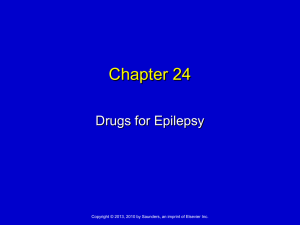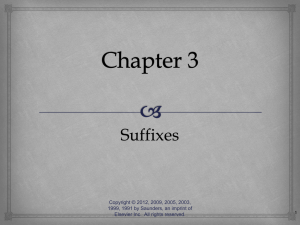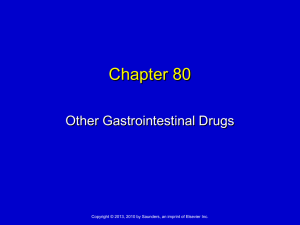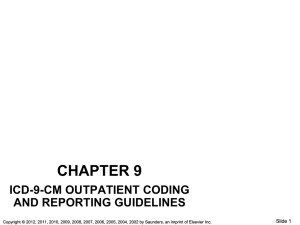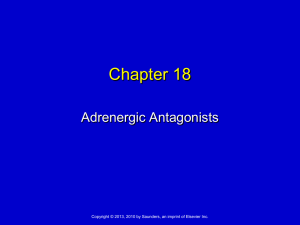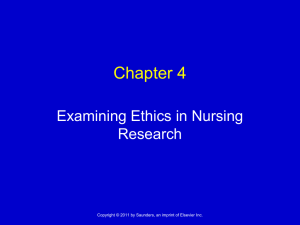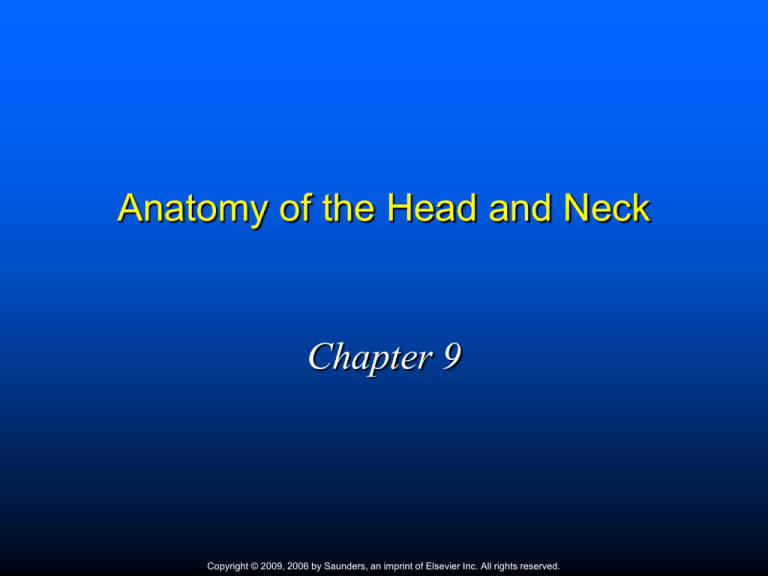
Anatomy of the Head and Neck
Chapter 9
Copyright © 2009, 2006 by Saunders, an imprint of Elsevier Inc. All rights reserved.
Chapter 9
Lesson 9.1
Copyright © 2009, 2006 by Saunders, an imprint of Elsevier Inc. All rights reserved.
Learning Objectives
Pronounce, define, and spell the Key Terms.
Identify the regions of the head.
Locate and identify the bones of the cranium
and face.
Identify the components of the
temporomandibular joint (TMJ).
Describe the action of the TMJ.
Integrate knowledge of the anatomy of the
head and neck into clinical practice.
Copyright © 2009, 2006 by Saunders, an imprint of Elsevier Inc. All rights reserved.
Introduction
The study of head and neck anatomy provides the
dental assistant with the anatomic basis for the
clinical practice of dental assisting.
You will learn about the muscles and the lymph nodes
in the neck, the bones of the skull and face, and the
salivary glands. You will also learn about
the muscles that create your facial expressions
and those that help you open and close your
mouth and swallow your food.
Copyright © 2009, 2006 by Saunders, an imprint of Elsevier Inc. All rights reserved.
Regions of the Head
The head is divided into regions:
Frontal
Occipital
Temporal
Orbital
Infraorbital
Buccal
Parietal
Mental
Nasal
Zygomatic
Oral
Copyright © 2009, 2006 by Saunders, an imprint of Elsevier Inc. All rights reserved.
Fig. 9-1 Regions of the head.
(From Fehrenbach MJ, Herring SW: Illustrated anatomy of the head and neck, ed 2, Philadelphia, 2002,
Saunders.)
Copyright © 2009, 2006 by Saunders, an imprint of Elsevier Inc. All rights reserved.
Bones of the Cranium
The cranial bones:
Single frontal
Occipital
Sphenoid
Ethmoid
Paired parietal
Paired temporal
Copyright © 2009, 2006 by Saunders, an imprint of Elsevier Inc. All rights reserved.
Fig. 9-2 Lateral view of the skull.
(From Abrahams PH, Marks Jr. SC, Hutchings RT: McMinn’s color atlas of human anatomy, ed 5, St Louis, 2003,
Mosby.)
Copyright © 2009, 2006 by Saunders, an imprint of Elsevier Inc. All rights reserved.
Fig. 9-3 Frontal view of the skull.
(From Abrahams PH, Marks SC Jr., Hutchings RT: McMinn’s color atlas of human anatomy, ed 5, St Louis, 2003,
Mosby.)
Copyright © 2009, 2006 by Saunders, an imprint of Elsevier Inc. All rights reserved.
Fig. 9-4 Posterior view of the skull.
(From Abrahams PH, Marks Jr. SC, Hutchings RT: McMinn’s color atlas of human anatomy, ed 5, St Louis, 2003,
Mosby.)
Copyright © 2009, 2006 by Saunders, an imprint of Elsevier Inc. All rights reserved.
Fig. 9-5 View of external base of the skull.
(From Abrahams PH, Marks Jr. SC, Hutchings RT: McMinn’s color atlas of human anatomy, ed 5, St Louis, 2003,
Mosby.)
Copyright © 2009, 2006 by Saunders, an imprint of Elsevier Inc. All rights reserved.
Bones of the Face
The bones visible on the anterior view of the
skull include the:
Lacrimal bone
Nasal bone
Vomer
Inferior nasal concha
Zygomatic bone
Maxilla
Mandible
Copyright © 2009, 2006 by Saunders, an imprint of Elsevier Inc. All rights reserved.
Fig. 9-6 Anterior view of facial bones and overlying
facial tissue.
(From Fehrenbach MJ, Herring SW: Illustrated anatomy of the head and neck, ed 2, Philadelphia, 2002,
Saunders.)
Copyright © 2009, 2006 by Saunders, an imprint of Elsevier Inc. All rights reserved.
Fig. 9-7 Bones and landmarks of the hard palate.
Copyright © 2009, 2006 by Saunders, an imprint of Elsevier Inc. All rights reserved.
Fig. 9-8 A, The mandible from the front.
(From Malamed S: Handbook of local anesthesia, ed 5, St Louis, 2004, Mosby.)
Copyright © 2009, 2006 by Saunders, an imprint of Elsevier Inc. All rights reserved.
Fig. 9-8 B, The mandible from behind and above.
(From Malamed S: Handbook of local anesthesia, ed 5, St Louis, 2004, Mosby.)
Copyright © 2009, 2006 by Saunders, an imprint of Elsevier Inc. All rights reserved.
Fig. 9-8 C, The mandible from the left and front.
(From Malamed S: Handbook of local anesthesia, ed 5, St Louis, 2004, Mosby.)
Copyright © 2009, 2006 by Saunders, an imprint of Elsevier Inc. All rights reserved.
Fig. 9-8 D, The mandible viewed from the internal and left.
(From Malamed S: Handbook of local anesthesia, ed 5, St Louis, 2004, Mosby.)
Copyright © 2009, 2006 by Saunders, an imprint of Elsevier Inc. All rights reserved.
Fig. 9-9 A, Fetal skull, anterior view.
(From Liebgott B: The anatomical basis of dentistry, ed 2, St Louis, 2001, Mosby.)
Copyright © 2009, 2006 by Saunders, an imprint of Elsevier Inc. All rights reserved.
Fig. 9-9 B, Fetal skull, lateral view.
(From Liebgott B: The anatomical basis of dentistry, ed 2, St Louis, 2001, Mosby.)
Copyright © 2009, 2006 by Saunders, an imprint of Elsevier Inc. All rights reserved.
Fig. 9-9 C, Fetal skull, posterior view.
(From Liebgott B: The anatomical basis of dentistry, ed 2, St Louis, 2001, Mosby.)
Copyright © 2009, 2006 by Saunders, an imprint of Elsevier Inc. All rights reserved.
Fig. 9-10 Stages of postnatal development of the human skull.
A, Anterior view. B, Lateral view.
(From Liebgott B: The anatomical basis of dentistry, ed 2, St Louis, 2001, Mosby.)
Copyright © 2009, 2006 by Saunders, an imprint of Elsevier Inc. All rights reserved.
The Temporomandibular Joint
The TMJ is a joint on each side of the head
that allows for movement of the mandible for
speech and mastication (chewing).
It takes its name from the two bones that
enter into its formation, the temporal bone
and the mandible.
Copyright © 2009, 2006 by Saunders, an imprint of Elsevier Inc. All rights reserved.
Bony Parts of the TMJ
Glenoid fossa
Articular eminence
Condyloid process
Copyright © 2009, 2006 by Saunders, an imprint of Elsevier Inc. All rights reserved.
Capsular Ligament
A fibrous joint capsule completely encloses
the TMJ.
The capsule wraps around the margin of the
temporal bone’s articular eminence and
articular fossa superiorly.
Inferiorly, the capsule wraps around the
circumference of the mandibular condyle,
including the condyle’s neck.
Copyright © 2009, 2006 by Saunders, an imprint of Elsevier Inc. All rights reserved.
Fig. 9-11 Lateral view of the joint capsule of the temporomandibular joint
and its lateral temporomandibular ligament. Note on the insert that the
capsule has been removed to show the upper and lower synovial cavitites
and their relationship to the articular disc.
(From Fehrenbach MJ, Herring SW: Illustrated anatomy of the head and neck, ed 2, Philadelphia, 2002, Saunders.)
Copyright © 2009, 2006 by Saunders, an imprint of Elsevier Inc. All rights reserved.
Jaw Movements of the TMJ
Two basic types of movement are performed
by the TMJ:
A hinge action
A gliding movement
Copyright © 2009, 2006 by Saunders, an imprint of Elsevier Inc. All rights reserved.
Fig. 9-12 Hinge and gliding actions of the TMJ.
Copyright © 2009, 2006 by Saunders, an imprint of Elsevier Inc. All rights reserved.
Disorders of the TMJ
A patient may experience a disease process
associated with one or both of the TMJs or a
temporomandibular disorder (TMD). TMD is
complex, involving such factors as:
Stress
Clenching
Bruxism
Copyright © 2009, 2006 by Saunders, an imprint of Elsevier Inc. All rights reserved.
Fig. 9-13 Palpation of the patient during movements of
both TMJs.
Copyright © 2009, 2006 by Saunders, an imprint of Elsevier Inc. All rights reserved.
Symptoms of TMJ Disorder
Pain
Joint sounds
Limitations of movement
Copyright © 2009, 2006 by Saunders, an imprint of Elsevier Inc. All rights reserved.
Chapter 9
Lesson 9.2
Copyright © 2009, 2006 by Saunders, an imprint of Elsevier Inc. All rights reserved.
Learning Objectives
Locate and identify the muscles of the head and
neck.
Identify the location of major and minor salivary
glands and associated ducts.
Identify and trace the routes of the blood vessels of
the head and neck.
Describe and locate the divisions of the trigeminal
nerve.
Identify the location of major lymph node sites in the
body.
Identify and locate the paranasal sinuses of the skull.
Copyright © 2009, 2006 by Saunders, an imprint of Elsevier Inc. All rights reserved.
Muscles of the Head and Neck
To perform a thorough patient examination, it
is necessary to know the location and action
of many muscles of the head and neck.
Malfunctions of muscles may be involved in
malocclusions (improper bite), TMJ disorder,
and even the spread of dental infections.
Copyright © 2009, 2006 by Saunders, an imprint of Elsevier Inc. All rights reserved.
Seven Main Groups of Muscles
Muscles of the neck
Muscles of facial expression
Muscles of mastication
Muscles of the tongue
Muscles of the soft palate
Muscles of the floor of the mouth
Muscles of the pharynx
Copyright © 2009, 2006 by Saunders, an imprint of Elsevier Inc. All rights reserved.
Two Muscles of the Neck
Sternocleidomastoid
Trapezius
Copyright © 2009, 2006 by Saunders, an imprint of Elsevier Inc. All rights reserved.
Fig. 9-14 Palpating the sternocleidomastoid muscle by having
the patient turn the head to the opposite side.
Copyright © 2009, 2006 by Saunders, an imprint of Elsevier Inc. All rights reserved.
Major Muscles of Facial Expression
Orbicularis oris: closes and puckers the lips
Buccinator: compresses the cheeks against
the teeth and retracts the angle of the mouth
Mentalis: raises and wrinkles the skin of the
chin and pushes the lower lip up
Zygomatic major: draws the angles of the
mouth upward and backward, as in laughing
Copyright © 2009, 2006 by Saunders, an imprint of Elsevier Inc. All rights reserved.
Major Muscles of Mastication
Temporal
Masseter
Internal (medial) pterygoid
External (lateral) pterygoid
Copyright © 2009, 2006 by Saunders, an imprint of Elsevier Inc. All rights reserved.
Fig. 9-15 Major muscles of mastication.
(From: From Applegate EG: Anatomy and physiology learning system, ed 2, Philadelphia, 2000, Saunders.)
Copyright © 2009, 2006 by Saunders, an imprint of Elsevier Inc. All rights reserved.
Muscles of the Floor of the Mouth
Digastric
Mylohyoid
Stylohyoid
Geniohyoid
Copyright © 2009, 2006 by Saunders, an imprint of Elsevier Inc. All rights reserved.
Fig. 9-16 View from above the floor of the oral cavity, showing the origin
and insertion of the geniohyoid muscle.
(From Fehrenbach MJ, Herring SW: Illustrated anatomy of the head and neck, ed 2, Philadelphia, 2002, Saunders.)
Copyright © 2009, 2006 by Saunders, an imprint of Elsevier Inc. All rights reserved.
Muscles of the Tongue
The tongue has two groups of muscles,
intrinsic (within the tongue) and extrinsic:
The intrinsic muscles are responsible for shaping
the tongue during speech, chewing, and
swallowing.
The extrinsic muscles assist in the movement
and function of the tongue.
Copyright © 2009, 2006 by Saunders, an imprint of Elsevier Inc. All rights reserved.
Extrinsic Muscles of the Tongue
Genioglossus: depresses and protrudes the
tongue
Hyoglossus: retracts and pulls down the side
of the tongue
Styloglossus: retracts the tongue
Palatoglossus: elevates the tongue and pulls
it slightly backward
Copyright © 2009, 2006 by Saunders, an imprint of Elsevier Inc. All rights reserved.
Fig. 9-17 Extrinsic muscles of the tongue.
Copyright © 2009, 2006 by Saunders, an imprint of Elsevier Inc. All rights reserved.
Muscles of the Soft Palate
Palatoglossus
Palatopharyngeus
Copyright © 2009, 2006 by Saunders, an imprint of Elsevier Inc. All rights reserved.
The Salivary Glands
The salivary glands produce saliva, which
lubricates and cleanses the oral cavity and
aids in the digestion of food through an
enzymatic process.
Saliva also helps maintain the integrity of
tooth surfaces through a process of
remineralization.
Salivary glands are classified by their size as
either major or minor.
Copyright © 2009, 2006 by Saunders, an imprint of Elsevier Inc. All rights reserved.
Fig. 9-18 The salivary glands.
(From Thibodeau GA, Patton KT: Anatomy & physiology, ed 5, St Louis, 2003, Mosby.)
Copyright © 2009, 2006 by Saunders, an imprint of Elsevier Inc. All rights reserved.
Types of Saliva
Serous: watery; mainly protein
Mucous: very thick; mainly carbohydrate
Copyright © 2009, 2006 by Saunders, an imprint of Elsevier Inc. All rights reserved.
Minor Salivary Glands
Smaller and more numerous than the major
salivary glands.
Scattered in the tissues of the buccal, labial,
and lingual mucosa; the soft palate; the
lateral portions of the hard palate; and the
floor of the mouth.
Ebner’s salivary gland is associated with the
large circumvallate papillae on the tongue.
Copyright © 2009, 2006 by Saunders, an imprint of Elsevier Inc. All rights reserved.
Major Salivary Glands
Parotid salivary gland: Saliva passes from the
parotid gland into the mouth through a duct
called the parotid duct (also known as the
Stensen duct).
Submandibular salivary gland releases saliva
into the oral cavity through the Wharton duct,
which ends in the sublingual caruncles.
Sublingual salivary gland releases saliva into
the oral cavity through the sublingual duct,
also known as the Bartholin duct.
Copyright © 2009, 2006 by Saunders, an imprint of Elsevier Inc. All rights reserved.
Disorders of the Salivary Glands
Xerostomia (dry mouth) can result in an
increase in dental decay and problems in
speech and chewing.
Salivary stones (sialoliths) may block duct
openings, preventing saliva from flowing into
the mouth.
Copyright © 2009, 2006 by Saunders, an imprint of Elsevier Inc. All rights reserved.
Fig. 9-19 A, Occlusal radiograph showing a sialolith (arrow) in
Wharton’s duct.
(From Ibsen O, Phelan JA, eds: Oral pathology for the dental hygienist, ed 4, St Louis, 2004, Saunders.)
A
Copyright © 2009, 2006 by Saunders, an imprint of Elsevier Inc. All rights reserved.
Fig. 9-19 B, Sialolith (arrow) in a minor salivary
gland on the floor of the mouth.
(From Ibsen O, Phelan JA, eds: Oral pathology for the dental hygienist, ed 4, St Louis, 2004,
Saunders.)
Copyright © 2009, 2006 by Saunders, an imprint of Elsevier Inc. All rights reserved.
Blood Supply to the Head and Neck
It is important to be able to locate the larger
blood vessels of the head and neck because
these vessels may become compromised by
disease or during such dental procedures as
local anesthetic injections.
Blood vessels may also spread infection in
the head and neck.
Copyright © 2009, 2006 by Saunders, an imprint of Elsevier Inc. All rights reserved.
Major Arteries of the Face
and Oral Cavity
The aorta ascends from the left ventricle of
the heart.
The common carotid artery arises from the
aorta and subdivides into the internal and
external carotid arteries.
The internal carotid artery supplies blood to
the brain and eyes.
The external carotid artery provides the major
blood supply for the face and mouth.
Copyright © 2009, 2006 by Saunders, an imprint of Elsevier Inc. All rights reserved.
Fig. 9-20 Major arteries and veins of the face and oral cavity.
Copyright © 2009, 2006 by Saunders, an imprint of Elsevier Inc. All rights reserved.
Trigeminal Nerve
Supplies the maxillary teeth,
periosteum, mucous membrane,
maxillary sinuses, and soft palate.
Subdivides into the:
Nasopalatine nerve
Greater palatine nerve
Anterior superior alveolar nerve
Middle superior alveolar nerve
Posterior superior alveolar nerve
Mandibular Division of the
Copyright © 2009, 2006 by Saunders, an imprint of Elsevier Inc. All rights reserved.
Fig. 9-21 Facial paralysis resulting from damage to lower motor
neurons of the facial nerve (cranial nerve VII).
(Redrawn from Liebgott B: The anatomical basis of dentistry, ed 2, St Louis, 2001, Mosby; and Wilson-Pauwels L,
Akesson EJ, Steward PA: Cranial nerves: anatomy and clinical comments, Toronto, 1998, BC Decker.)
Copyright © 2009, 2006 by Saunders, an imprint of Elsevier Inc. All rights reserved.
Fig. 9-22 The 12 cranial nerves.
Copyright © 2009, 2006 by Saunders, an imprint of Elsevier Inc. All rights reserved.
Innervation of the Oral Cavity
The trigeminal nerve is the primary source of
innervation for the oral cavity. The trigeminal
nerve subdivides into three main branches:
Maxillary
Mandibular
Ophthalmic (not discussed in this chapter)
Copyright © 2009, 2006 by Saunders, an imprint of Elsevier Inc. All rights reserved.
Maxillary Division of the
Trigeminal Nerve
Supplies the maxillary teeth, periosteum,
mucous membrane, maxillary sinuses, and
soft palate.
Subdivides into the:
Nasopalatine nerve
Greater palatine nerve
Anterior superior alveolar nerve
Middle superior alveolar nerve
Posterior superior alveolar nerve
Copyright © 2009, 2006 by Saunders, an imprint of Elsevier Inc. All rights reserved.
Mandibular Division of the
Trigeminal Nerve
The mandibular division of the trigeminal
nerve subdivides into:
The buccal, which supplies branches to the buccal
mucous membrane and to the mucoperiosteum of
the mandibular molar teeth
The lingual, which supplies the anterior two thirds
of the tongue and gives off branches to supply the
lingual mucous membrane and mucoperiosteum
The inferior alveolar nerves, which subdivide into
the mylohyoid nerve, mental nerve, incisive nerve,
and small dental nerves that supply the molar and
premolar teeth, alveolar process, and periosteum
Copyright © 2009, 2006 by Saunders, an imprint of Elsevier Inc. All rights reserved.
Fig. 9-23 Maxillary and mandibular innervation.
Copyright © 2009, 2006 by Saunders, an imprint of Elsevier Inc. All rights reserved.
Fig. 9-24 Palatal, lingual, and buccal innervation.
Copyright © 2009, 2006 by Saunders, an imprint of Elsevier Inc. All rights reserved.
Lymph Nodes of the Head and Neck
A dental professional must examine and
palpate the lymph nodes of the head and
neck very carefully during extraoral
examination.
Enlarged lymph nodes may indicate infection
or cancer. The lymph nodes for the oral cavity
drain intraoral structures, such as the teeth,
as well as the eyes, ears, nasal cavity, and
deeper areas of the throat.
Copyright © 2009, 2006 by Saunders, an imprint of Elsevier Inc. All rights reserved.
Lymph Nodes
Lymph nodes are small round or oval
structures located in lymph vessels.
The major sites of lymph nodes include:
Cervical (in the neck)
Axillary (under the arms)
Inguinal (in the lower abdomen)
The lymph nodes of the head are classified
as superficial (near the surface) or deep.
Copyright © 2009, 2006 by Saunders, an imprint of Elsevier Inc. All rights reserved.
Superficial Lymph Nodes of the Head
There are five groups of superficial lymph
nodes in the head:
Occipital
Retroauricular
Anterior auricular
Superficial parotid
Facial nodes
Copyright © 2009, 2006 by Saunders, an imprint of Elsevier Inc. All rights reserved.
Fig. 9-25 A, Superficial lymph nodes of the head and
associated structures.
(From Fehrenbach MJ, Herring SW: Illustrated anatomy of the head and neck, ed 2, Philadelphia, 2002, Saunders.)
Copyright © 2009, 2006 by Saunders, an imprint of Elsevier Inc. All rights reserved.
Deep Cervical Lymph Nodes
The deep cervical lymph nodes are located
along the length of the internal jugular vein
on each side of the neck, deep to the
sternocleidomastoid muscle.
Copyright © 2009, 2006 by Saunders, an imprint of Elsevier Inc. All rights reserved.
Fig. 9-25 B, Deep cervical lymph nodes and associated structures.
(From Fehrenbach MJ, Herring SW: Illustrated anatomy of the head and neck, ed 2, Philadelphia, 2002, Saunders.)
Copyright © 2009, 2006 by Saunders, an imprint of Elsevier Inc. All rights reserved.
Lymphadenopathy
When a patient has an infection or cancer in
a particular region, the lymph nodes in that
region will respond by increasing in size and
becoming very firm.
Lymphadenopathy results from an increase in
both the size of each lymphocyte (lymphocyte
cells are the body's main defense) and the
overall cell count in the lymphoid tissue.
With an increase in the size and number of
lymphocytes, the body is better able to fight
the disease.
Copyright © 2009, 2006 by Saunders, an imprint of Elsevier Inc. All rights reserved.
Paranasal Sinuses
The paranasal sinuses are air-containing
spaces within the skull that communicate with
the nasal cavity.
The functions of the sinuses include:
Producing mucus
Making the bones of the skull lighter
Providing resonance that helps produce sound
The sinuses are named for the bones in
which they are located.
Copyright © 2009, 2006 by Saunders, an imprint of Elsevier Inc. All rights reserved.
The Sinuses
The maxillary sinuses are the largest of the
paranasal sinuses.
The frontal sinuses are located within the
forehead, just above both eyes.
The ethmoid sinuses are irregularly shaped
air cells separated from the orbital cavity by a
very thin layer of bone.
The sphenoid sinuses are located close to
the optic nerves, where an infection may
damage vision.
Copyright © 2009, 2006 by Saunders, an imprint of Elsevier Inc. All rights reserved.
Fig. 9-26 The paranasal sinuses.
Copyright © 2009, 2006 by Saunders, an imprint of Elsevier Inc. All rights reserved.

